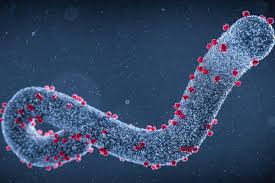Marburg Virus Disease:

Six people have died in Rwanda following an outbreak of the Marburg virus, the country’s Health Ministry said recently.
- Marburg Virus Disease earlier known as Marburg hemorrhagic fever, is a rare but severe hemorrhagic fever that affects both people and non-human primates.
- MVD is caused by the Marburg virus, a genetically unique zoonotic (animal-borne) RNA virus. Marburg and Ebola viruses are both members of the Filoviridae family (filovirus).
- The virus takes its name from the German city of Marburg, where it was first identified in 1967 in a lab where workers had been in contact with infected green monkeys imported from Uganda.
- The reservoir host of the Marburg virus is the African fruit bat, Rousettus aegyptiacus.
- The virus can be transmitted from bats to primates, including humans, and then spread through direct contact with blood or other body fluids from infected individuals.
- Initial Marburg disease signs and symptoms include Fever, Chills, Headache, Muscle aches, Rash with both flat and raised bumps, often on the torso, Chest pain, Sore throat, Nausea, vomiting, and diarrhea
- As the disease advances, symptoms can become more severe, including liver failure, delirium, shock, bleeding (hemorrhaging), and multi-organ dysfunction.
- The average MVD case fatality rate is around 50%. Case fatality rates have varied from 24% to 88% in past outbreaks depending on virus strain and case management.
- There is no treatment or vaccine for Marburg disease.
- Supportive therapy, such as intravenous fluids, electrolyte replacement, supplemental oxygen, as well as blood and blood products replacement, improves survival.




